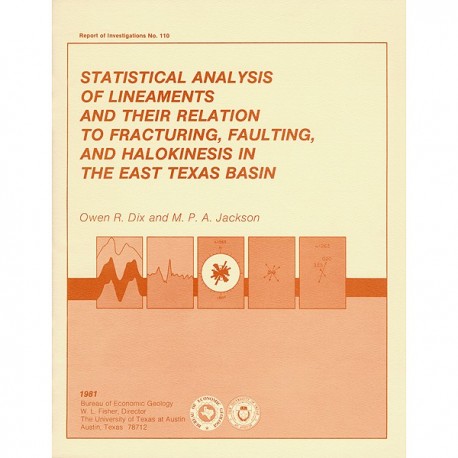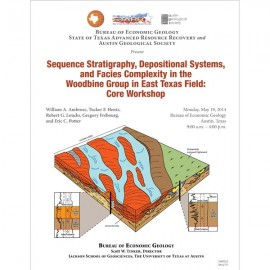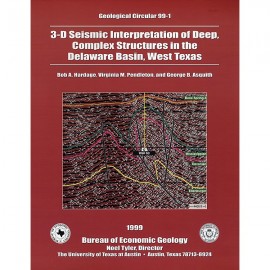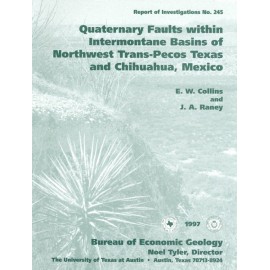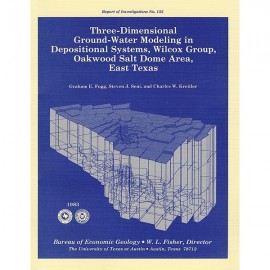Reports of Investigations
-
Books & Reports
- Reports of Investigations
- Guidebooks
- Udden Series
- Geological Circulars
- Down To Earth
- Atlases of Major Oil and Gas Reservoirs
- Texas Memorial Museum Publications
- Environmental Geologic Atlas of the Texas Coastal Zone
- Mineral Resource Circulars
- Other Reports
- Seminars and Workshops
- Handbooks
- Submerged Lands of Texas
- Symposia
- Annual Reports
- Open File Reports
-
Maps & Cross Sections
- Thematic Maps
- Miscellaneous Maps, Charts & Sections
- Geologic Atlas of Texas
- STATEMAP Project Maps
- Geologic Quadrangle Maps
- Cross Sections
- Highway Geology Map
- Energy and Mineral Resource Maps
- Shoreline Change and Other Posters
- Wilcox Group, East Texas, Geological / Hydrological Folios
- Bouguer Gravity Atlas of Texas
- River Basin Regional Studies
- Featured Maps
- Posters
- Teachers & the Public
-
Geological Society Publications
- Gulf Coast Association of Geological Societies
- Alabama Geological Society
- Austin Geological Society
- Corpus Christi Geological Society
- Houston Geological Society
- Lafayette Geological Society
- Mississippi Geological Society
- New Orleans Geological Society
- South Texas Geological Society
- GCS SEPM Publications
- Historic BEG & UT Series
Statistical Analysis of Lineaments and Their Relation to Fracturing, Faulting, and Halokinesis in the East Texas Basin
RI0110
Statistical Analysis of Lineaments and Their Relation to Fracturing, Faulting, and Halokinesis in the East Texas Basin, by O. R. Dix and M. P. A. Jackson. 30 p., 27 figs., 4 tables, 1981. ISSN: 0082335X: Print Version.
A free, digital version of this publication can be found on: Texas ScholarWorks
RI0110. Statistical Analysis of Lineaments and Their Relation to Fracturing, Faulting, and Halokinesis in the East Texas Basin, by O. R. Dix and M. P. A. Jackson. 30 p., 27 figs., 4 tables, 1981. ISSN: 0082335X: Print.
To purchase this publication as a downloadable PDF, please order RI0110D.
ABSTRACT
Lineament analysis is part of a broad spectrum of structural studies employed to determine the tectonic stability of the East Texas Basin. Such information is necessary to assess the suitability of East Texas salt domes as possible repository sites for the storage of high-level nuclear wastes. A sequence of statistical operations was designed to identify and assess the significance of lineament preferred orientation by means of a variety of statistical tests or parameters, including vector summation, length weighting, X2, F, and t testing, the Bernshtein accuracy criterion, and an index of preferred orientation. Black-and-white aerial photographs, at scales between 1:17,400 and 1:25,500, and band-5 Landsat imagery were analyzed. Well-defined, northeast-trending and northwest-trending lineament populations are present throughout the East Texas Basin. The northeast trend, comprising two peaks oriented at 045° and 055°, corresponds to the orientation of the Mexia-Talco peripheral fault zone, to subsurface faults in the center of the basin, and to some lithologic contacts. The northwest trend comprises two peaks oriented at 310° and 325°. Both the northeast and northwest trends are thought to result from preferential directions of fracture induced by interference folding at depth. This folding is caused by halokinesis and is reflected in the regional gravity field. The Elkhart - Mount Enterprise fault zone has exerted little noticeable effect on the regional lineament pattern, mainly because of its subparallel orientation. Areas above shallow salt domes, particularly those in the southern part of the basin, are associated with higher lineament densities and lower preferred orientation of lineaments than are non-dome areas or areas above deep salt diapirs; this probably reflects radial and concentric fault and fracture patterns above the shallow domes. Analysis of computer-generated, geologically meaningless sets of “lineaments” strongly suggests that confidence levels of 99 percent are necessary to exclude randomly generated peaks, and that the significance of orthogonal pairsets has been exaggerated in the literature.
Keywords: lineament, statistical analysis, East Texas Basin, halokinesis, nuclear waste storage, fault pattern
Citation
Dix, O. R., and Jackson, M. P. A., 1981, Statistical Analysis of Lineaments and Their Relation to Fracturing, Faulting, and Halokinesis in the East Texas Basin: The University of Texas at Austin, Bureau of Economic Geology, Report of Investigations No. 110, 30 p.
